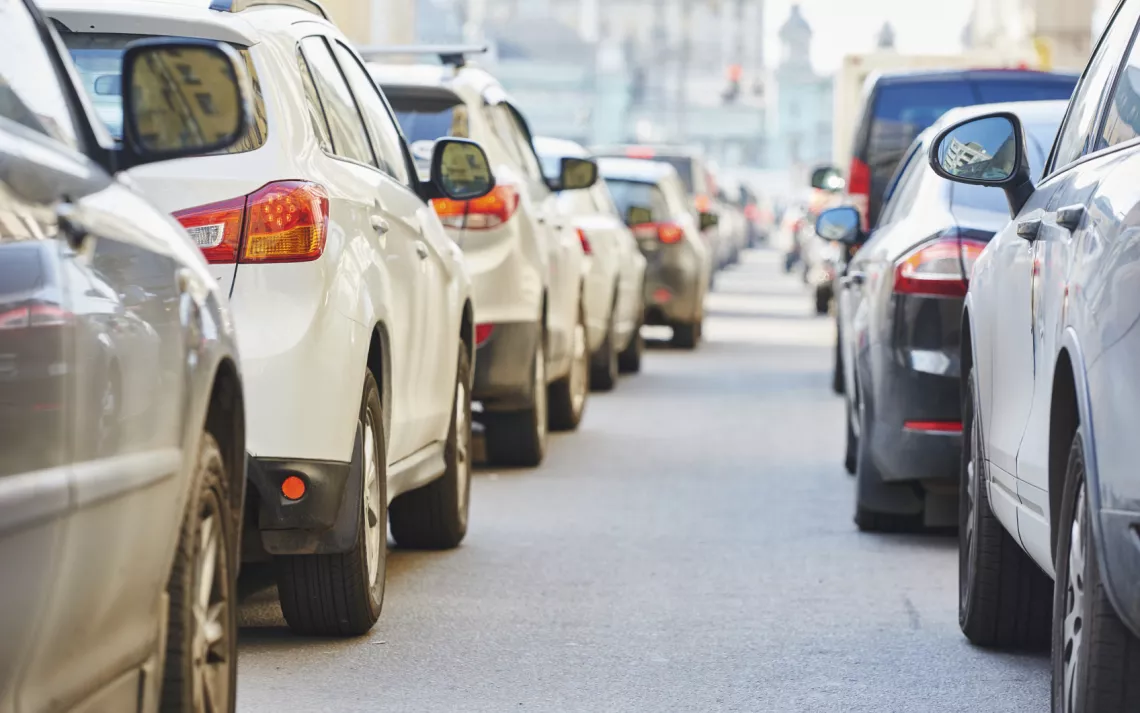Is the Sharing Economy Truly Green?
Sarah and Jorge both love Uber. They dig everything about it—how quickly it arrives, especially compared to San Francisco’s crummy taxi service, and the efficiency of the app, which allows them to track the driver’s arrival. The service gives them a sense of independence without owning a vehicle, and it’s hugely popular among their demographic of urban, progressive-leaning, pro-environmental hipsters.
For Sarah, Jorge, and their cohorts, sharing-economy companies like Uber are deeply infused with green values, a notion that the companies have carefully cultivated. Uber CEO Travis Kalanick claims that Uber is reducing traffic congestion. “How many cars are off the road because of this, how good this is for the environment," he says. Kalanick wants to make Uber so ubiquitous that car-loving Americans will give up their personal vehicles and just use Uber.
Prominent voices such as Van Jones, Rachel Botsman, and Annie Leonard have said that the sharing economy—whether car-sharing, home-sharing or “stuff”-sharing—is a way of using fewer resources by sharing what we have and producing and consuming less. The environmental benefits of home-sharing services like Airbnb and stuff-sharing platforms like Spinlister, Poshmark, and SnapGoods have become conventional wisdom. A 2015 PricewaterhouseCoopers study found that 76 percent of American adults who are familiar with the sharing economy believe that it’s better for the environment.
But, in fact, hard data on the environmental benefits of the sharing economy is difficult to come by. Many green claims are anecdotal, and to the extent that we have data, the accumulating evidence indicates that the sharing economy is not quite so pro-environment. On the contrary, it appears that some services are having a harmful environmental impact by fueling an increase in personal consumption.
Case in point: Uber, Lyft, and ride-sharing. The cities where ride-sharing has become popular are now increasingly afflicted by extreme traffic congestion. In San Francisco (where I live), Seattle, New York City, London, and other cities, traveling from point A to point B, especially in the downtown core, has become an arduous task.
Yet few people are making the connection between traffic conditions and the huge influx of thousands of ride-sharing cars on the road. When I asked Sarah and Jorge if it was taking them longer to go places, Jorge rolled his eyes and said, “It’s horrible. You have to leave 20 extra minutes now to get anywhere. Sometimes longer. And parking? Forget about it.” When I suggested that all the new ride-sharing drivers were contributing mightily to the city’s arterial obstruction, they looked like I had stolen their Christmas presents.
Ed Reiskin, director of transportation for San Francisco’s Municipal Transportation Agency, says, "[Uber and Lyft] have put a lot more vehicles on the streets," an estimated 15,000 autos in San Francisco alone. Not all of those vehicles are on the street at any one time, but thousands typically are, many of which double-park in bike lanes and bus stops when dropping off passengers, further snarling traffic flow. "They’re all contributing to the increased traffic,” Reiskin says.
In London, a study by the Department for Transport found that the rise of taxi apps such as Uber has played a part in worsening congestion. The number of private-hire vehicles has jumped 26 percent in the past few years, according to the city agency.
Seattle’s mayor, Ed Murray, in observing the impact of Uber on the city, says, "There's some fear out there … that if you replace cars driving to work with [Uber] cars just driving around looking for rides, we could find ourselves in a challenging situation.” Ride-sharing technology makes the problem worse, he says.
In New York City, where there are now twice as many Uber and Lyft cars as yellow taxis, transportation analyst Charles Komanoff has crunched Uber’s own numbers and estimated that Uber-caused congestion has reduced traffic speeds in the central business district by about 8 percent. Mayor Bill DeBlasio tried to take on Uber over its contribution to congestion, but he ran into a political buzz saw, including opposition from high-ranking Democratic Party operative David Plouffe, who Uber hired from the Obama administration. DeBlasio then called for a study of traffic congestion, but when the study was finally released many months later, it was roundly condemned by traffic experts as being “unbelievably flimsy” for its lack of key details. Uber has become skilled at lobbying city halls across the country, often resulting in politics trumping environmental impacts.
Zipcar likes to tout certain studies as evidence for its pro-environment bona fides, but there appears to be a measure of exaggeration as well as truth in its claims. Zipcar has said that “every Zipcar takes at least 20 personally owned vehicles off the road.” But a Transportation Research Board study found that only five private vehicles are replaced by each shared car. Another study found that Zipcar’s business-class users had “eliminated the need for roughly 33,000 vehicles across North America.” While that is something of an accomplishment, it’s a modest one: The figure represents only .0013 percent of the 253 million cars in the United States.
Certainly ride-sharing is not the only cause of urban traffic increase—an improving economy also contributes to it. But I’ve lived in San Francisco for 20 years, and I’ve seen the city streets in both good economic times and bad. The effects of congestion are felt at the margins—once a city has reached capacity, it takes only a few additional vehicles to suddenly turn a tolerable situation into one of desperate overcapacity. Urban cores cannot simply add thousands of additional cars to already-crowded streets and not expect dramatic knock-on effects.
It seems that we are bedeviled by a “clash of conveniences”—the Uber car shows up much faster than a taxi, but now you sit in traffic longer. If we think of our streets as a “public utility,” we have to find the right mix of buses, bicycles, personal autos, delivery trucks, taxis, and now ride-sharing vehicles. Because as congestion increases, other crucial environmental goals get steamrolled—such as reducing carbon emissions by encouraging greater use of mass transit and bicycling.
A recent University of California Transportation Center study of ride-sharing customers in the San Francisco area found that nearly half of respondents said that if they had not had the option of using a ride-sharing service, they would have instead used a bike, public bus, or train, or simply walked. Ride-sharing is taking away business, not just from traditional taxis, but also from more low-carbon modes of travel.
Indeed, ride-sharing may turn out to be a direct threat to public transit. The economics of public transit systems are built around the busiest bus or train lines, which are heavily used and profitable, subsidizing other routes which are not so full. That equation is crucial in allowing a public transit system to be citywide and serving less-populated neighborhoods. If a ride-sharing company like Uber begins offering service that sprints up and down the busiest and most profitable routes, such passenger poaching could destroy revenue for public transit. In Spain, the National Federation of Bus Transportation (Fenebús) has called for the closure of ride-sharing company BlaBlaCar because its operations are reducing the ridership of the mass transit companies.
In its effort to grab more market share, Uber has launched UberPool, which is experimenting with a new ride option in which cars drive multiple passengers along a specific route, just like traditional bus lines. While any effort to get more passengers in Uber cars should be commended, we have to make sure that it does not undermine public transportation, or else it will result in a backward step, environmentally.
Beyond ride-sharing, there are other claims that home-sharing and various types of goods-sharing benefit the environment. In theory, by maximizing the use of underutilized properties and possessions, society will reduce production and consumption. But even the Economist, a publication normally bullish on the gig economy, admits, “In many cases, the benefits of sharing-economy services are that they reduce cost and improve convenience—both of which might, in fact, boost consumption.” The “sharing” platforms are creating new markets that appear to be expanding the volume of commerce. Professor Juliet Schor from Boston College, who also has been pro-sharing economy, says, “The actual environmental impacts of the [sharing] sites are far more complicated." To assess overall ecological impacts, Schor says, “we have to consider ripple effects. My students and I have found that Airbnb users are taking more trips now and that the availability of cheap ride services is diverting some people from public transportation. That means the platforms result in higher carbon emissions.”
Airbnb, like Uber, fights back against the critics with its own commissioned studies. But the company’s research is based on questionable methodology and its own proprietary (and often cherry-picked) data. With a $25 billion valuation that is triple that of the 50-year-old Hyatt Hotels Corporation, Airbnb has alleged that its guests “use 63 percent less energy than hotel guests,” as well as less water, therefore emitting fewer greenhouse gas emissions. But the company has refused to reveal how these studies reached these conclusions and has “refused to allow its full study to be published online,” according to the tech news site VentureBeat.
The notion that sharing will lead society to produce less stuff also shows little understanding of the “economics of depreciation.” If more people are sharing the same device, it means that device will have to be replaced sooner.
For example, let’s look again at ride-sharing. A typical person drives approximately 15,000 miles per year, so their car will last approximately 12 years (assuming around 180,000 miles for the life of the auto). But many Uber drivers report racking up 400 to 1000 miles per week, so a driver could easily accumulate 35,000 miles per year or more. Instead of lasting 12 years, that car will now last barely five. (Many inexperienced Uber drivers don’t seem to consider that wear and tear will force them to replace their vehicle much sooner, which must be factored into any calculations about the adequacy of Uber wages.)
The economics of depreciation would also apply when commercially “sharing” your bicycle, your electric drill, your washing machine, and most other types of personal property. Crucially, it’s not only the number of devices produced that is important, but the number of “usage hours” put on each device. If your shared items have more “usage hours,” they will wear out more quickly.
Certainly if you never use your backpack or TV and barter or sell it to someone who doesn’t own that item (that's the goal of “truly sharing” companies like Adam Werbach’s Yerdle, which facilitates such swaps), then one fewer backpack or TV will be produced. It seems reasonable that with more people sharing property, a bit less stuff might be consumed. But the impact probably will be much less dramatic than is assumed by sharing-economy proponents.
Many well-meaning, environment-friendly people have bought the line that the sharing economy is green. But there’s no hard data showing that, and the claims of environmental sustainability remain more theoretical than actual. Meanwhile, there’s ample evidence that some sharing services, such as ride-sharing and home-sharing, are actually taking us backward from meeting the pressing environmental challenges that we face. When it comes to the “greenness” of the sharing economy, magical thinking and corporate press releases have replaced fact-based discourse.
 The Magazine of The Sierra Club
The Magazine of The Sierra Club








